Apr 7, 2017
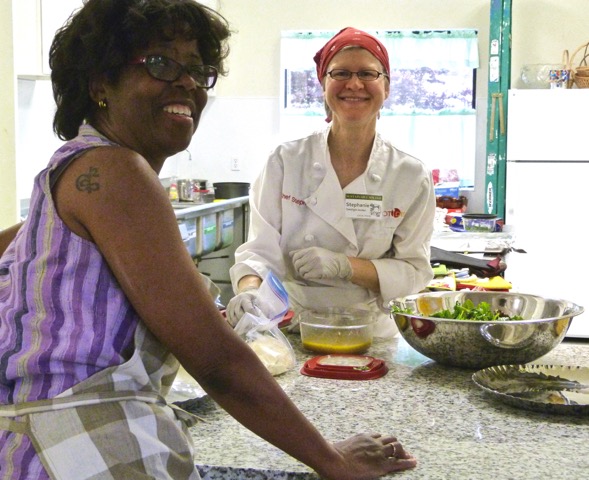
Chef Stephanie Oelsligle Jordan at Heritage Presbyterian Church kitchen with Chef Veronica Bearce, helper for the night.
Over the year, a special partnership has been growing between Sustainable Solano and Heritage Presbyterian Church, for the sake of creating a Community Food Center in Benicia, a dream that’s been taking shape with inspiration from Sustainable Solano’s Exec Director, Elena Karoulina and local chef Stephanie Oelsligle Jordan, and from the church’s Pastor Yung Me Morris and Heritage Presbyterian Church’s leadership board.
So what would a Benicia Community Food Center be, and be for?
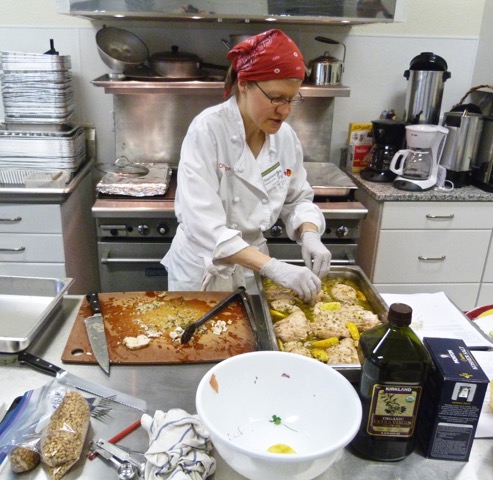 In the evening, April 5th, Sustainable Solano hosted members of Heritage’s congregation for a beautiful, seasonal buffet dinner prepared by chef Stephanie to discuss and celebrate the promise of a mutual venture that would be centered around the church’s as yet under-utilized kitchen. Recently, the church had had upgraded the kitchen, but not quite up to the commercial standard for select uses, such as for a catering business. Seeking funds for the necessary improvements to meet those standards (not for restaurant permitting level), the church and Sustainable Solano will be working toward that basic aim. Meanwhile, hope is afloat for creating an earth-friendly catering service led by local chefs who would prepare meals for “take out” for Benicia residents who don’t have the time, ability or income to cook healthy meals at home. In the future, residents who elect to participate would become subscribers to the program. Such a business arrangement would benefit local small farms and other local/regional suppliers of wild fish, organic meats, eggs and dairy. Becoming a community food “hub”, Heritage Presbyterian would become the delivery and pick up location for CSA (Community Supported Agricultural) boxes, as well as for deliveries of other food supplies (meats, fish, eggs, dairy). With Sustainable Solano’s “Swenson Garden” and Community Orchard located on the church property, it appears that HPC is growing into its new role helping to foster local access and distribution of healthy food within Benicia.
In the evening, April 5th, Sustainable Solano hosted members of Heritage’s congregation for a beautiful, seasonal buffet dinner prepared by chef Stephanie to discuss and celebrate the promise of a mutual venture that would be centered around the church’s as yet under-utilized kitchen. Recently, the church had had upgraded the kitchen, but not quite up to the commercial standard for select uses, such as for a catering business. Seeking funds for the necessary improvements to meet those standards (not for restaurant permitting level), the church and Sustainable Solano will be working toward that basic aim. Meanwhile, hope is afloat for creating an earth-friendly catering service led by local chefs who would prepare meals for “take out” for Benicia residents who don’t have the time, ability or income to cook healthy meals at home. In the future, residents who elect to participate would become subscribers to the program. Such a business arrangement would benefit local small farms and other local/regional suppliers of wild fish, organic meats, eggs and dairy. Becoming a community food “hub”, Heritage Presbyterian would become the delivery and pick up location for CSA (Community Supported Agricultural) boxes, as well as for deliveries of other food supplies (meats, fish, eggs, dairy). With Sustainable Solano’s “Swenson Garden” and Community Orchard located on the church property, it appears that HPC is growing into its new role helping to foster local access and distribution of healthy food within Benicia.
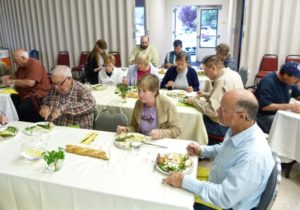
Heritage Presbyterian Church and Sustainable Solano Board members sharing meal and a conversation
Everyone attending the dinner enjoyed the delicious meal and applauded chef Stephanie. Most importantly, good questions were raised with the realization that answers and solutions could be found. Essentially, everyone felt the groundswell of excitement in cooperating to support the pilot plan for an enterprise that would serve people’s nutrition and health and community well-being. The vision was growing as everyone spoke up with ideas, such as connecting with Carquinez Village, St. Paul’s, and CAC. We were seizing the time and season for change—the time for learning and enabling new ways of doing and being together for the good of all life.
Mar 17, 2017
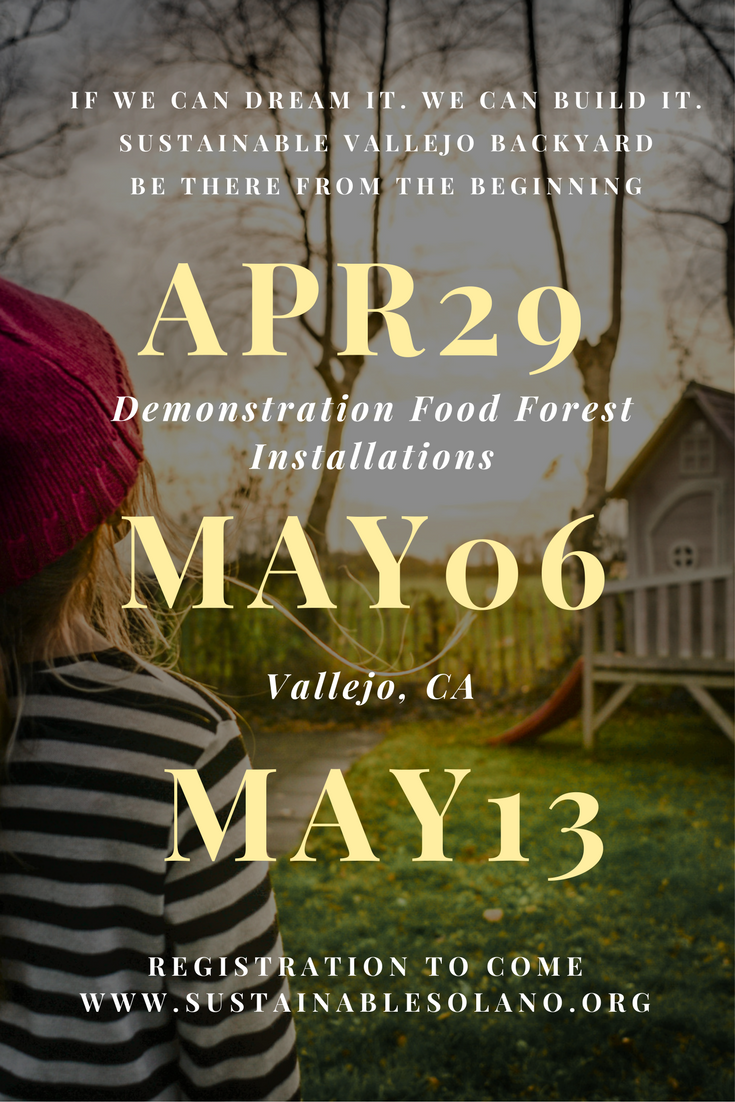
Each day includes a talk from a Permaculture Designer and hands-on practice building a food forest. The workshops are FREE. Lunch is provided by the homeowners. Learn while helping your community! See a site-specific permaculture design manifest into reality.
April 29th Registration Laying down the foundation: sheet mulching a lawn, digging on contour swales, making berms, diverting the roof water and planting trees.
May 6th Registration Learn and install a Laundry-to-Landscape grey water system.
May 13th Registration Planting, installing a water efficient drip system, and mulching.
Mar 3, 2017
Our Seasonal Cooking Seafood Class is Wednesday, March 8 and we’re cooking through our CSF partner’s weekly seafood box, so we did a little Q&A with Anna Larsen of Siren Fish Co.
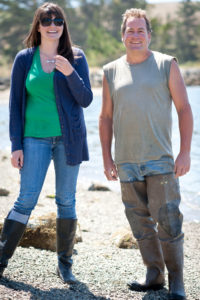
Why CSF?
Community supported fisheries reduce food miles, educate the public on their local fishing community, provide seafood of unparalleled variety and freshness, and encourage fishers to use more sustainable fishing methods. It’s a win for all parties!
Where does Siren source?
We mainly source from Bodega Bay and Ft. Bragg, with occasional jaunts to Monterey and a rare trip to Santa Barbara to source white sea bass. All of our finfish is wild and all of our shellfish is sustainably farmed in open ocean beds.
How is it different than the seafood we get at Monterey Fish Market or Tokyo Fish Market or Berkeley Bowl?
There are a few key differences, the most apparent being freshness. Because we are asking members to select their shares in advance, we are able to time our buying so that the fish is generally 1 to 2 days out of the water. We don’t need to keep fish in a case until we sell it, we bring in and immediately send out just what we need. Also, since we are sourcing only a couple of items at a time, we are able to provide details on the fisher or farmer who produced your catch, as well as maintain very tight quality and sourcing controls.
I love seafood but am scared to commit to cooking it every (week?). Any advice?
We make sure that you are prepared to cook and enjoy whatever we send you. You’ll have step by step storage and preparation instructions as well as recipes. Also, since our seafood is coming directly from the water to you, you actually have 5 days or so to prepare your share before the quality starts to drop off. There’s no need to rush to cook most items on the day you receive them. There are exceptions to this (herring, sand dabs) but we will alert members in advance that these items need to be enjoyed immediately. We also allow members to put their shares on hold for vacations, scheduling conflicts, or when life gets too busy to cook.
We offer many drop locations and home delivery throughout the bay area!
Benicia and
Vallejo drop-offs are on Wednesdays. A full updated listing can be found
here.Mar 1, 2017
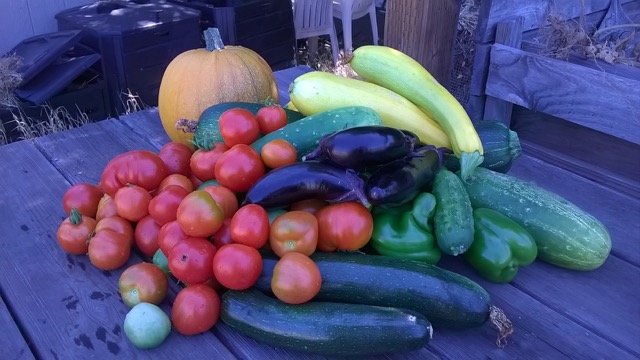
Share Plot Harvest, July 2016
Benicia Community Gardens Annual Meeting on February 18, 2017
After a brief welcome by Marilyn Bardet, Board President, our executive director, Elena Karoulina, explained that the Benicia Community Gardens and Orchard are now part of Sustainable Solano. In the past few years Elena and the Board have added many new initiatives, including 7 food forests in Benicia and consumer supported agriculture programs to supply residents with sustainably sourced vegetables, meat, fish, and other food products. The food forests have saved an impressive amount of water. These accomplishments caught the attention of Solano County officials, who asked our group to bring some of these programs to other parts of Solano County. So the name change reflects the new and broader mission of bringing sustainable food (in many forms) to Solano County.
The group then heard from the coordinators of Avant Garden, Swenson Garden and the Community Orchard. Avant Garden is almost full, but many of the beds at Swenson are empty. The Share plot at Avant Garden provided over 700 pounds, an impressive amount of food! All 3 coordinators requested increased participation in work days. As discussed last year, people who did not provide the minimum hours last year will be charged extra this year. Annual agreements were signed and the annual fees were collected. Agreements and fees for 2017 are due by March 21. Contact your garden coordinator if you missed the Feb 18 meeting!
Mar 1, 2017
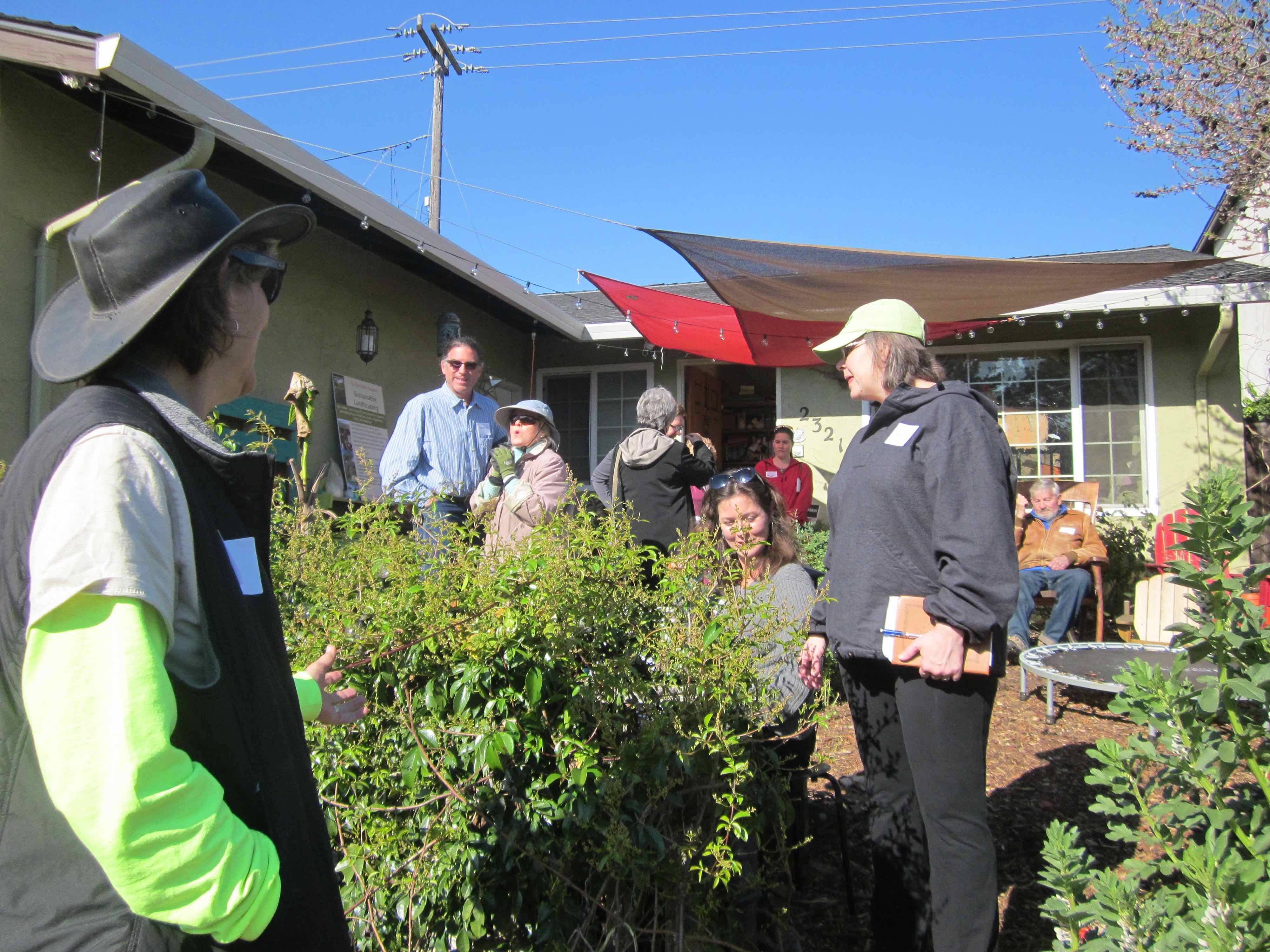
It was a cool and sunny day for the Greyhawk Grove Tour, and perhaps it was that, or that our tour is gathering steam, that nearly 30 people squeezed into a room to listen to Lydia Neilsen from the Regenerative Design Institute. She started with a brief overview of permaculture design principles: people care, earth care–and then dove straight into practical, simple applications to one’s garden, covering hands-on details of creating swales (or as someone coined them, “Magical ditches”), appreciating weeds and the natural succession of plant life, and mimicking that healthy ecosystem balance in tree and plant guilds. She fielded questions about greywater, and, noting that several Food Forest Keepers were in attendance, had them field questions as well. Attendees remarked on on simple, clear, and practical her talk was.
The overflowing group then spilled out into the demonstration food forest itself, were Lydia pulled up a giant fava bean to show the group the roots and speak about cover crops, nitrogen fixation and soil health. She also ate a nodule, declaring it tasted like peanuts and offered it to anyone who wanted to try. They were able to see the laundry-to-landscape switch and pipes, look at the greywater basins, the rainwater pipes that flowed straight into the two swales, how the natural slope and chicken coop was incorporated into the planning, and snuggle up the free range chickens who were milling about. “We used to have one of these at the farm,” said the farm director of Loma Vista Farms after she cuddled up a polish chicken–known for a mop of feathers on top of its head that looks like punk-rocker hair. “We used to call it our Tina Turner chicken. But now the kids don’t get the reference. I guess rockstar chicken still works.”
It was a rockstar day all around. And we look forward to the next stop in the tour–stop #6, “The Curious Garden.”
For more information and to register for “The Curious Garden”, please go here.

 In the evening, April 5th, Sustainable Solano hosted members of Heritage’s congregation for a beautiful, seasonal buffet dinner prepared by chef Stephanie to discuss and celebrate the promise of a mutual venture that would be centered around the church’s as yet under-utilized kitchen. Recently, the church had had upgraded the kitchen, but not quite up to the commercial standard for select uses, such as for a catering business. Seeking funds for the necessary improvements to meet those standards (not for restaurant permitting level), the church and Sustainable Solano will be working toward that basic aim. Meanwhile, hope is afloat for creating an earth-friendly catering service led by local chefs who would prepare meals for “take out” for Benicia residents who don’t have the time, ability or income to cook healthy meals at home. In the future, residents who elect to participate would become subscribers to the program. Such a business arrangement would benefit local small farms and other local/regional suppliers of wild fish, organic meats, eggs and dairy. Becoming a community food “hub”, Heritage Presbyterian would become the delivery and pick up location for CSA (Community Supported Agricultural) boxes, as well as for deliveries of other food supplies (meats, fish, eggs, dairy). With Sustainable Solano’s “Swenson Garden” and Community Orchard located on the church property, it appears that HPC is growing into its new role helping to foster local access and distribution of healthy food within Benicia.
In the evening, April 5th, Sustainable Solano hosted members of Heritage’s congregation for a beautiful, seasonal buffet dinner prepared by chef Stephanie to discuss and celebrate the promise of a mutual venture that would be centered around the church’s as yet under-utilized kitchen. Recently, the church had had upgraded the kitchen, but not quite up to the commercial standard for select uses, such as for a catering business. Seeking funds for the necessary improvements to meet those standards (not for restaurant permitting level), the church and Sustainable Solano will be working toward that basic aim. Meanwhile, hope is afloat for creating an earth-friendly catering service led by local chefs who would prepare meals for “take out” for Benicia residents who don’t have the time, ability or income to cook healthy meals at home. In the future, residents who elect to participate would become subscribers to the program. Such a business arrangement would benefit local small farms and other local/regional suppliers of wild fish, organic meats, eggs and dairy. Becoming a community food “hub”, Heritage Presbyterian would become the delivery and pick up location for CSA (Community Supported Agricultural) boxes, as well as for deliveries of other food supplies (meats, fish, eggs, dairy). With Sustainable Solano’s “Swenson Garden” and Community Orchard located on the church property, it appears that HPC is growing into its new role helping to foster local access and distribution of healthy food within Benicia.





